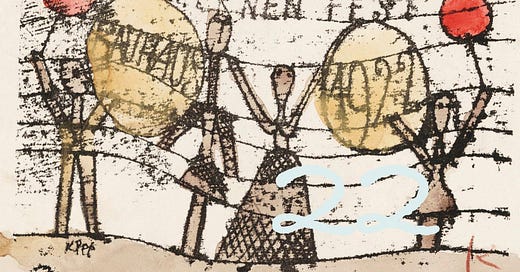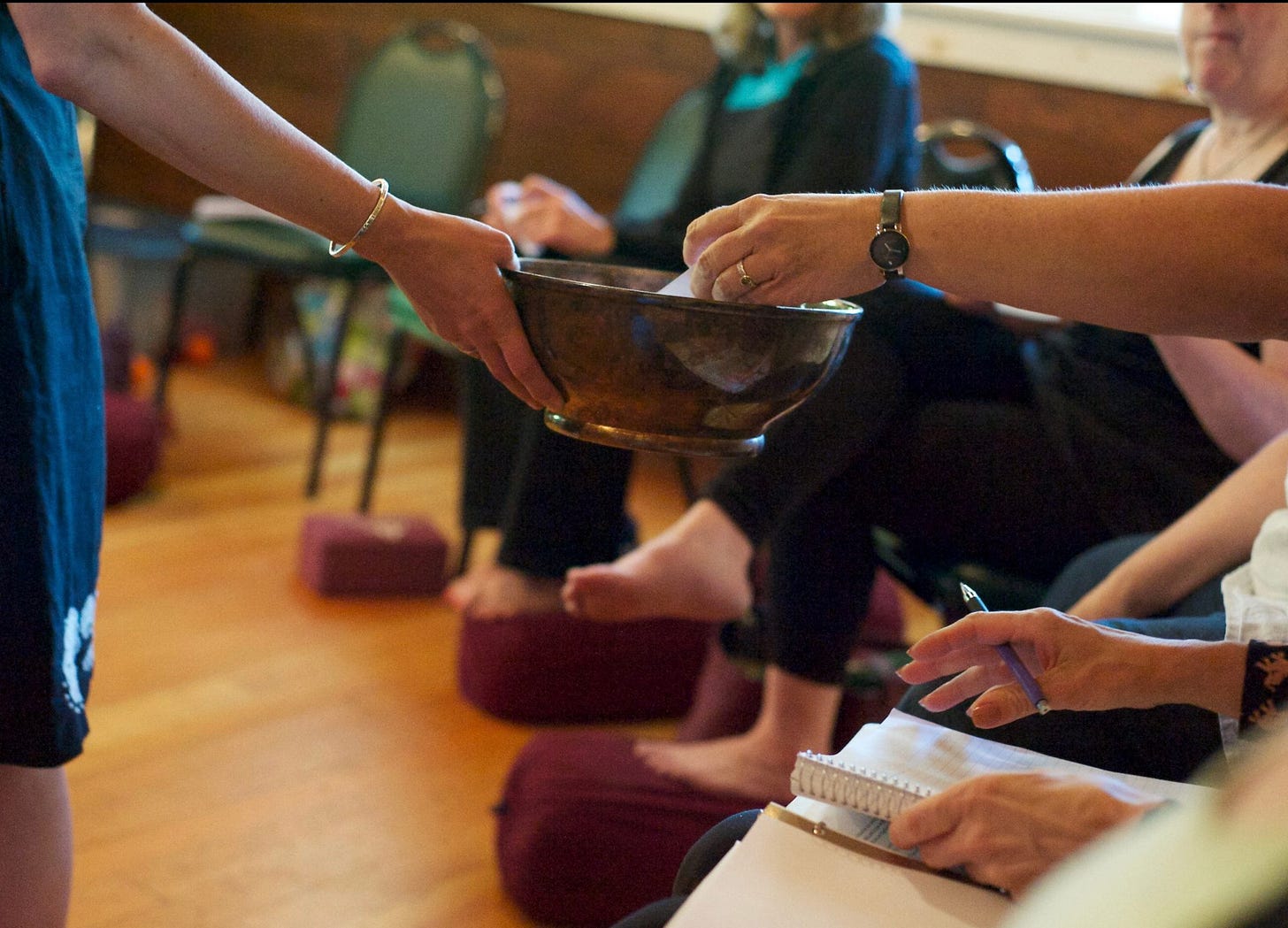Nothing, not one thing, hurts us more — or causes us to hurt others more — than our certainties. ~Maria Popova
Creative Prompt #22: Jeu Parti, A Literary Question & Answer Game
Postcard: Paul Klee to Katherine Dreier, Paris
Writing in the Dark—this newsletter, that is—shares the name of my most popular synchronous writing course, a virtual writing workshop which I conceived of in March, 2020, as the world shut down, and which launched less than a month later, that April. The name felt exactly fitting for what we were all experiencing as creatives in a time of profound uncertainty. And, like the prompts you’ve been introduced to in this 30-Day Creativity Challenge, the methods and materials in Writing in the Dark reflect a belief in the value of allowing for the unknown, and respecting the unknown, as an element of creative process. Today’s prompt is a fun, unusual, easy to execute 10-step, 10-minute exercise to reveal the magic of the unknown—and it’s an exercise you can repeat as many times as you like, including as a fantastic party trick. If you’ve ever been on retreat with me, you have undoubtedly laughed or gasped or both over the effects of this exercise. And if you want to skip straight to the prompt, you can scroll to the bolded heading Creativity Prompt #22: Jeu Parti, A Literary Question & Answer Game.
But if you want to know why we’re doing it and, more importantly, why it works, read on for a bit more the genesis of this exercise and its foundations.
You see, I was able to launch the Writing in the Dark quickly because I was already the founder, director, and—at that time—sole teaching faculty of a small, independent creative writing program called Elephant Rock, which itself is named for a childhood place of importance to me—the “real” Elephant Rock is a giant rock formation that abuts a beautiful creek in Duluth’s Lincoln Park (Duluth is a city nestled at the southern tip of the North Shore of Lake Superior—it’s a harsh and beautiful place). I loved Elephant Rock as a child, and love it still today, for the way it engages imagination and possibility through the intersection of language and the world. This intersection is a place of profound possibility, which is how I feel about creative writing.
Indeed, Elephant Rock as a creative program was founded and operates still today on the principle that writing should be a discovery, a grand unearthing, a continual surprise, not a recitation. Elephant Rock’s offerings (which are now taught by a vibrant roster of teaching artists in addition to myself) encourage writers to "peer over the edge of doubt" in the tradition of the Romantic poet John Keats, who developed the intriguing theory of "Negative Capability"—i.e., the willingness and ability to “befriend uncertainty” and, as a result, develop more capacity to perceive unlimited possibility. Extraordinary writing exercises dissolve unseen barriers. Prompts and constraints in the style of the French surrealists and the renowned Oulipo ("workshop of potential literature") lead to hidden truths.
I was first introduced to these philosophies and methods by the poet and teacher Paul Matthews, with whom I was lucky enough to study with in 2009. Since that time, I’ve quoted Paul more than any other teacher (by far) because in truth, he completely transformed my approach to the page and made it possible for me to write about difficult things in inventive (and marvelous!) ways I would never have previously attempted. As I wrote for Cleaver Magazine a couple of years ago:
Playfulness, Paul told us, is the portal to the profound: the English word “silly” comes from the German selig—which means, according to the Babylon German-English Dictionary, soulful, full of feeling, blessed, late, deceased. These opposites work synergistically. As eighteenth-century philosopher Frederich Schiller wrote in his aesthetic letters, “Humans are fully human only when we play, and we only play when we are human in the fullest sense of the word.” Schiller also said art belongs in the same realm of total freedom as play. Both offer the possibility of becoming childlike, of losing ourselves in experience and—according to Matthews—“healing the division in our consciousness.”
In other words, Elephant Rock and, along with it, all of my teaching is grounded in the spirit of actively inviting more uncertainty, not less.
It’s no wonder, then, that I was so moved by what Maria Popova of the Marginalian wrote recently when discussing George Saunders and his invocation for us to love the world more and have courage for uncertainty. Popova said:
Nothing, not one thing, hurts us more — or causes us to hurt others more — than our certainties. The stories we tell ourselves about the world and the foregone conclusions with which we cork the fount of possibility are the supreme downfall of our consciousness. They are also the inevitable cost of survival, of navigating a vast and complex reality most of which remains forever beyond our control and comprehension. And yet in our effort to parse the world, we sever ourselves from the full range of its beauty, tensing against the tenderness of life.
Then, naming art as “the eternal sandbox of doubt,” Popova goes on to quote George Saunders, who, in A Swim in the Pond in the Rain, his highly celebrated (and for good reason!) craft book, says:
In a world full of people who seem to know everything, passionately, based on little (often slanted) information, where certainty is often mistaken for power, what a relief it is to be in the company of someone confident enough to stay unsure (that is, perpetually curious).
This topic is so inspiring to me that I could write a long-form essay or even a book about the essential role of uncertainty in art-making. However, for today, I will stop here and let you experience a little of this for yourself, using a method that’s slightly less conventional and yet substantially more obvious and direct than most of our prompts so far in regard to revealing the limits of our certainty and the potential to be found in releasing our grip on it.
To complete this exercise, you will need 10 – 15 minutes, a timer, a pen, and 20 small pieces of paper (about the size of index cards).
First, though, before we get to brass tacks (aka instructions), a confession: I have never, not even one time, tried to teach this exercise to people who are not in the same room with me, which is what you see pictured above. For this reason, I simply can’t know whether it will work or not when taught at a distance. What I can tell you is that I have taught this exercise dozens of times—in an ice house on an island in Wisconsin, at lodges on the North Shore of Lake Superior, in a mid-century modern retreat in Illinois, perched on the rocks of Madeline Island, on the beach in Troncones, Mexico, and in the Lit 2 Classroom at Stillwater Prison. Also, in my living room during Write for Your Life workshops over and over again. And it has always, every single time, without a single fail, not only worked, but produced pure brilliance comprised in equal parts of hilarity and profundity.






